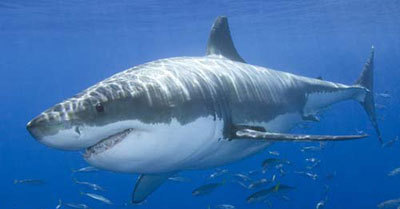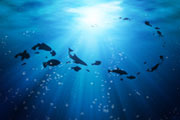Our planet is filled with amazing animals and cool critters. Take the ocean, for example. There are so many things to "see" in the "sea" - creatures of all shapes and sizes, with all sorts of different, fascinating behaviors. Check out some facts about some ocean animals you may be familiar with - and others you may have never even heard of!
Oh, Octopus!
What sea creature has a soft body, eight arms and lives on the ocean floor? An octopus, of course! While octopuses are best known for their multiple arms, it's what they can do with their eight limbs that's totally weird. Octopuses can actually taste their food with the suction cups that dot each of their arms. Plus, they can detach an arm on purpose! Why? Because after it detaches it still wiggles, which attracts predators while the octopus makes a quick getaway!

More awesome octopus facts:
- The mimic octopus can change its shape and color to look like other, more dangerous sea creatures, like an eel, snake fish or lionfish.
- Octopuses can spray a black ink in the face of another creature that's pursuing them. This ink makes predators' lose their vision and sense smell.
- Octopuses have been known to collect shells and other objects to build fortresses around their homes.
Not Just Jelly
What animal's head is so full of jelly, there's no room left for a brain? A jellyfish! Jellyfish are one of the oldest living creatures on earth, dating back over 650 million years. The "jelly" in a jellyfish is a thick, elastic substance that gives this sea animal it shape and name.

More fun jellyfish facts:
- Jellyfish are dangerous because they release poison from their tentacles that "stings" - in fact, more than just painful, the box jellyfish's sting may just be the most poisonous on earth!
- A jellyfish's transparent body helps it hide from its predators, making it virtually invisible.
- The lion mane jellyfish can grow to be over 120 feet (37 meters) long!
Super Squid
The vampire squid is actually more closely related to an octopus than a squid. Living in the deep sea, this squid is famous for its huge eyes, which are about as large as human eyes. In fact, they have the largest eye-to-body ratio of any animal in the world - their eyes alone make up about 10% of their 12-inch bodies! If humans had eyes of those proportions, they'd have to be as large as our faces!

More stupendous squid facts:
- Vampire squids need their giant eyes because they live more than 3,000 feet below the ocean surface - a place that's darker than you can imagine!
- When squids see a predator, they distract it by releasing a cloud of sticky mucus full of glowing blue balls.
- The ideal water temperature for the vampire squid is a chilly 35 degrees Fahrenheit - brrrr!
Crazy Coral
Brain coral can live up to 200 years! This type of coral is made up of the skeletons of tiny sea creatures and can be found in shallow, warm-water coral reefs. And even though it may not seem like much more than a rock, there is something living and breathing beneath the coral's surface.

More cool coral facts:
- Check out the brain coral's tentacles. During the day, these tiny arms are pulled in close to their bodies for protection. At night, they shoot out to catch food.
- Some corals use their stinging tentacles against other, competing brain corals.
- Brain coral can survive strong storms that break other types of coral. They use their tentacles to tightly grip onto their surroundings.
Adorable Dugongs
Dugongs are often called sea cows, but they're actually related to elephants. In fact, these large marine mammals even have ivory tusks jutting out from the sides of their mouths, which the males use to fight other males and females use to protect their babies. And their long, powerful snouts are similar to an elephant's trunk. Dugongs use their snouts to vacuum up seagrass from the ocean floor.

More dynamite dugong facts:
- Dugongs are serious eaters! One dugong can devour a bed of seagrass the size of a soccer field in one day!
- Sailots exploring the tropics once accidentally thought dugongs they saw off in the distance were mermaids!
- The name "dugong" means "lady of the sea."
Beware Of Sharks!
The great white shark is the largest predatory fish in the ocean. They can grow to 15 feet long. Their mouths are lined with up to 300 sharp teeth, two to three rows deep. Shark teeth are easy to find - a shark loses as many as 30,000 teeth in its lifetime.
 Great White Shark
Great White Shark
More sha-la-la shark facts:
- Sharks lost their teeth easily because their teeth aren't connected to their jaws (like ours are). Instead, they sit in the shark's gums, with replacement teeth constantly growing in the gums below.
- The whale shark has 300 rows of tiny teeth!
- Despite all those sharp teeth, great whites don't chew their food. It would be like you trying to chew your food with just your front teeth!
Splendid Sea Stars
Sea stars are spiny, hard-skinned animals that live on the sea floor. But don't be fooled by their cute shape - they're actually brutal predators that can devour prey that's much larger than their mouths. Their secret is - they have two stomachs! One digests the food and the other extends out from the sea star's body to eat its prey. Sea stars use their arms to open things like clam shells, then they squeeze their second stomachs into the opening, where it eats the clam from the inside. When it's full, the sea star pulls back its stomach and lets go of the empty shell.

More stupendous sea star facts:
- Sea stars arms can grow right back if something happens to them.
- Sea stars are the only animals with feet on their arms!
Amazing Angelfish
Queen Angelfish are absolutely beautiful, with sparkling blue and yellow bodies, rounded heads, ringed spots on their foreheads that look like crowns, a top or dorsal fin that runs the entire length of their bodies and solid yellow tail. Unlike most fish, queen angelfish are usually found in pairs that stay together for life!

More astounding angelfish facts:
- Females can lay up to 75,000 eggs at once.
- Females can lay up to 10 million eggs during one breeding season.
- Young queen angelfish will set up a cleaning station and pick parasites off the skin of bigger fish like hammerhead sharks.

































